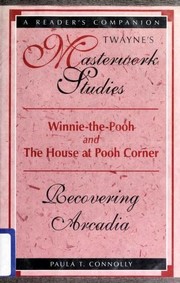Check nearby libraries
Buy this book

In the Forest of A. A. Milne's Winnie-the-Pooh (1926) and The House at Pooh Corner (1928), we never see any "Hostile Animals" as one the size of a piglet might fear, but instead we see a community of toy animals - Pooh Bear, Piglet, Rabbit, Eeyore, Owl, Kanga, Roo, and Tigger - who accompany their friend. Christopher Robin on his "expeditions." Companionship, safe adventuring, and the acceptance of characters' flaws and foibles are common themes throughout both books, and the episodes tend to have a similar form in which characters meet, adventure together, and then either reconcile if need be or, more frequently, return to their homes - in Pooh's case, usually for some honey.
In this affectionate and balanced analysis of two of the most popular books ever written for children, Paula T. Connolly argues that Milne's toy characters and his Christopher Robin - a character modeled and named after his son - inhabit a pretechnological, Arcadian world. Milne's Forest ensures its inhabitants' safety much like the Edwardian nursery, according to Connolly - a world, she acknowledges, of privilege and class security. The 10 stories in each book function well as separate bedtime stories, but they are held together as sets not only through the same Forest world that they inhabit and the same characters who live there but also through the similarity of themes.
Connolly notes that whereas the stories of Winnie-the-Pooh show a world of parties and adventuring, those of The House at Pooh Corner are a bit more sober: when the animals join together to say goodbye to Christopher Robin at the end of the book, the farewell is more muted than jubilant. The imminent departure of the child who had been seen asthe Forest's protector fundamentally reshapes the vision of the Forest as an unchanging Arcadia: such new concerns are apparent, for example, in the several incidents in which homes and characters are lost, sought after, and recovered. The interactions of the characters - and the...
--jacket flap
Check nearby libraries
Buy this book

Previews available in: English
Subjects
Arcadia in literature, Books and reading, Boys in literature, Children, Children's stories, English, English Pastoral fiction, History, History and criticism, Pastoral fiction, English, Teddy bears in literature, Winnie-the-Pooh (Milne, A.A.), House at Pooh Corner (Milne, A.A.)People
A. A. Milne, Winnie-the-Pooh, Christopher RobinPlaces
Great Britain, House at Pooh Corner, Pooh CornerTimes
20th centuryShowing 3 featured editions. View all 3 editions?
| Edition | Availability |
|---|---|
|
1
Winnie-the-Pooh and The House at Pooh Corner: Recovering Arcadia
1995, Twayne Publishers
Hardcover
in English
0805788107 9780805788105
|
aaaa
Libraries near you:
WorldCat
|
|
2
Winnie-The-Pooh and the House at Pooh Corner: Recovering Arcadia (Twayne's Masterwork Studies, No 156)
December 1994, Twayne Publishers
Paperback
in English
0805788115 9780805788112
|
zzzz
Libraries near you:
WorldCat
|
|
3
Masterwork Studies Series - Winnie-the-Pooh
December 9, 1994, Twayne Publishers
Board book
in English
- 1 edition
0805788107 9780805788105
|
zzzz
Libraries near you:
WorldCat
|
Book Details
Edition Notes
Includes bibliographical references (p. 135-138) and index.
Classifications
The Physical Object
ID Numbers
Community Reviews (0)
Feedback?| December 13, 2019 | Edited by MARC Bot | import existing book |
| July 17, 2019 | Edited by Lisa | Edited without comment. |
| July 17, 2019 | Edited by Lisa | work details |
| July 17, 2019 | Edited by Lisa | Added new cover |
| December 10, 2009 | Created by WorkBot | add works page |













